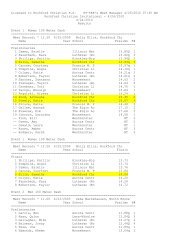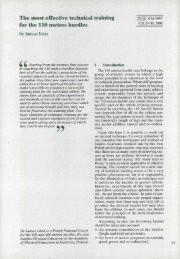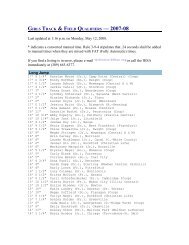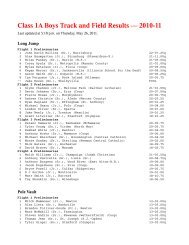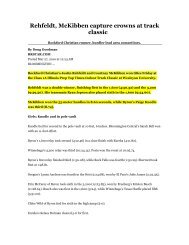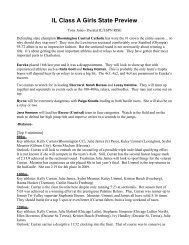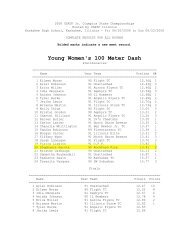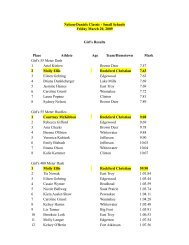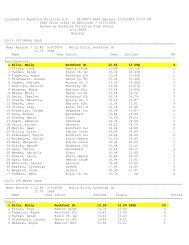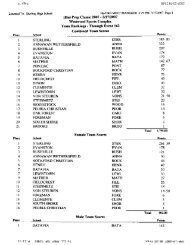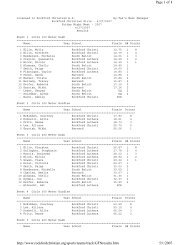kinematic analysis of hurdling performances at 2000 united states ...
kinematic analysis of hurdling performances at 2000 united states ...
kinematic analysis of hurdling performances at 2000 united states ...
You also want an ePaper? Increase the reach of your titles
YUMPU automatically turns print PDFs into web optimized ePapers that Google loves.
coincide with the hurdle clearance position r<strong>at</strong>her than in front. If this alignment <strong>of</strong> the trajectory peak<br />
was made then the hurdlers would not need to produce as gre<strong>at</strong> an elev<strong>at</strong>ion and shorter flight times<br />
would result. Only, one <strong>of</strong> the high hurdlers’ CM peak trajectories coincided with the hurdle clearance.<br />
The hurdlers’ average take-<strong>of</strong>f distance was 224.6 cm and their landing distance was 143.8 cm. These<br />
displacements were very close to the 213 cm (7 ft) take-<strong>of</strong>f and 122 cm (4 ft) landing displacements, th<strong>at</strong><br />
are typically discussed by hurdle coach clinicians. The alter<strong>at</strong>ions in the horizontal velocities <strong>of</strong> the CM<br />
during the take-<strong>of</strong>f found th<strong>at</strong> the high hurdlers increased their velocity by 13 cmhsec - 1 or<br />
approxim<strong>at</strong>ely 1% <strong>of</strong> their running velocity. These acceler<strong>at</strong>ive changes in the horizontal velocities for<br />
the hurdlers would be indic<strong>at</strong>ive <strong>of</strong> an appropri<strong>at</strong>e stride length foot <strong>at</strong> foot plant prior to take-<strong>of</strong>f.<br />
During the landing phase, the hurdlers experienced an acceler<strong>at</strong>ion <strong>of</strong> 84 cmhsec -1 or about 7.6% <strong>of</strong><br />
their running velocity, as they came over <strong>of</strong> the hurdle, which would be indic<strong>at</strong>ive <strong>of</strong> the hurdler landing<br />
in a tall running position r<strong>at</strong>her than settling and retarding their running velocity. The applic<strong>at</strong>ion <strong>of</strong><br />
gre<strong>at</strong>er horizontal forces would be indic<strong>at</strong>ed by shorter ground contact times and those horizontal forces<br />
may only be gener<strong>at</strong>ed when the hurdler is contact on the ground, therefore long flight times while<br />
clearing the hurdle would not be beneficial in achieving fast <strong>hurdling</strong> times. The small vertical CM<br />
displacements observed for the hurdlers during hurdle clearance indic<strong>at</strong>ed th<strong>at</strong> the hurdlers strode over<br />
the hurdle, thus reducing the flight time and increasing the acceler<strong>at</strong>ion <strong>of</strong> the body when in contact with<br />
the ground.<br />
CONCLUSIONS: The hurdlers experienced their gre<strong>at</strong>est acceler<strong>at</strong>ion during the landing phase after<br />
the hurdle clearance than the step prior to take-<strong>of</strong>f. Only one <strong>of</strong> the four hurdlers’ apex <strong>of</strong> their CM<br />
flight trajectory occurred over the hurdle. The hurdlers’ apex <strong>of</strong> their CM parabolic p<strong>at</strong>hway should<br />
occur while clearing the hurdle. A horizontal displacement between the CM apex and the hurdle would<br />
be indic<strong>at</strong>ive <strong>of</strong> improper striding or flight trajectories, where the take-<strong>of</strong>f step occurred too close or too<br />
far from the hurdle or they projected their body <strong>at</strong> an improper angle. An apex displacement would<br />
indic<strong>at</strong>e th<strong>at</strong> the hurdler reached his peak flight position either slightly before or after the hurdle. The<br />
simultaneous integr<strong>at</strong>ion <strong>of</strong> video, stick figures and d<strong>at</strong>a was used as a visual coaching and research tool<br />
for performing a hurdle <strong>analysis</strong> and providing immedi<strong>at</strong>e feedback to the <strong>at</strong>hlete and coach.<br />
REFERENCES:<br />
Finch, A., Ariel, G., & McNichols, J. (<strong>2000</strong>). Integr<strong>at</strong>ed <strong>kinem<strong>at</strong>ic</strong> d<strong>at</strong>a <strong>analysis</strong> <strong>of</strong> American elite<br />
hurdlers. In: Proceedings <strong>of</strong> Intern<strong>at</strong>ional Symposium on Biomechanics in Sports XVIII, The University<br />
<strong>of</strong> Hong Kong, Hong Kong, China.<br />
Mann, R. (1993). The mechanics <strong>of</strong> sprinting and <strong>hurdling</strong>. Elite Hurdler Project technical report.<br />
United St<strong>at</strong>es Track & Field Associ<strong>at</strong>ion, 1-135.<br />
McDonald, C., & Dapena, J. (1991). Linear <strong>kinem<strong>at</strong>ic</strong>s <strong>of</strong> the men’s 110-m and women’s 100-m<br />
hurdles races. Medicine & Science in Sports & Exercise, 23:1382-91.



